Related Research Articles

Lidar is a method for determining ranges by targeting an object or a surface with a laser and measuring the time for the reflected light to return to the receiver. It can also be used to make digital 3-D representations of areas on the Earth's surface and ocean bottom of the intertidal and near coastal zone by varying the wavelength of light. It has terrestrial, airborne, and mobile applications.

Condensation is the change of the state of matter from the gas phase into the liquid phase, and is the reverse of vaporization. The word most often refers to the water cycle. It can also be defined as the change in the state of water vapor to liquid water when in contact with a liquid or solid surface or cloud condensation nuclei within the atmosphere. When the transition happens from the gaseous phase into the solid phase directly, the change is called deposition.

A mushroom cloud is a distinctive mushroom-shaped flammagenitus cloud of debris, smoke and usually condensed water vapor resulting from a large explosion. The effect is most commonly associated with a nuclear explosion, but any sufficiently energetic detonation or deflagration will produce the same effect. They can be caused by powerful conventional weapons, like thermobaric weapons, including the ATBIP and GBU-43/B Massive Ordnance Air Blast. Some volcanic eruptions and impact events can produce natural mushroom clouds.
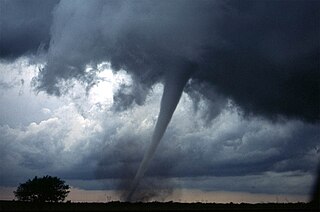
Weather modification is the act of intentionally manipulating or altering the weather. The most common form of weather modification is cloud seeding, which increases rain or snow, usually for the purpose of increasing the local water supply. Weather modification can also have the goal of preventing damaging weather, such as hail or hurricanes, from occurring; or of provoking damaging weather against the enemy, as a tactic of military or economic warfare like Operation Popeye, where clouds were seeded to prolong the monsoon in Vietnam. Weather modification in warfare has been banned by the United Nations under the Environmental Modification Convention.

In meteorology, precipitation is any product of the condensation of atmospheric water vapor that falls under gravitational pull from clouds. The main forms of precipitation include drizzle, rain, sleet, snow, ice pellets, graupel and hail. Precipitation occurs when a portion of the atmosphere becomes saturated with water vapor, so that the water condenses and "precipitates" or falls. Thus, fog and mist are not precipitation but colloids, because the water vapor does not condense sufficiently to precipitate. Two processes, possibly acting together, can lead to air becoming saturated: cooling the air or adding water vapor to the air. Precipitation forms as smaller droplets coalesce via collision with other rain drops or ice crystals within a cloud. Short, intense periods of rain in scattered locations are called showers.

Cloud seeding is a type of weather modification that aims to change the amount or type of precipitation that falls from clouds by dispersing substances into the air that serve as cloud condensation or ice nuclei, which alter the microphysical processes within the cloud. Its effectiveness is debated; some studies have suggested that it is "difficult to show clearly that cloud seeding has a very large effect." The usual objective is to increase precipitation, either for its own sake or to prevent precipitation from occurring in days afterward.
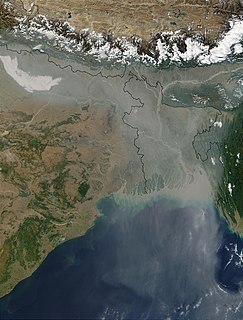
Cloud condensation nuclei (CCNs), also known as cloud seeds, are small particles typically 0.2 µm, or 1/100 the size of a cloud droplet on which water vapor condenses. Water requires a non-gaseous surface to make the transition from a vapor to a liquid; this process is called condensation. In the atmosphere of Earth, this surface presents itself as tiny solid or liquid particles called CCNs. When no CCNs are present, water vapor can be supercooled at about −13 °C (9 °F) for 5–6 hours before droplets spontaneously form. In above-freezing temperatures, the air would have to be supersaturated to around 400% before the droplets could form.
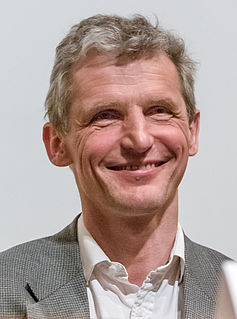
Wolfgang Ketterle is a German physicist and professor of physics at the Massachusetts Institute of Technology (MIT). His research has focused on experiments that trap and cool atoms to temperatures close to absolute zero, and he led one of the first groups to realize Bose–Einstein condensation in these systems in 1995. For this achievement, as well as early fundamental studies of condensates, he was awarded the Nobel Prize in Physics in 2001, together with Eric Allin Cornell and Carl Wieman.

A cloudburst is an extreme amount of precipitation in a short period of time, sometimes accompanied by hail and thunder, which is capable of creating flood conditions. Cloudbursts can quickly dump large amounts of water, e.g. 25 mm of precipitation corresponds to 25,000 metric tons per square kilometre. However, cloudbursts are infrequent as they occur only via orographic lift or occasionally when a warm air parcel mixes with cooler air, resulting in sudden condensation. At times, a large amount of runoff from higher elevations is mistakenly conflated with a cloudburst. The term "cloudburst" arose from the notion that clouds were akin to water balloons and could burst, resulting in rapid precipitation. Though this idea has since been disproven, the term remains in use.
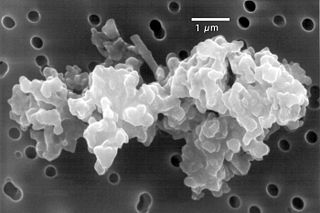
Cosmic dust, also called extraterrestrial dust or space dust, is dust which exists in outer space, or has fallen on Earth. Most cosmic dust particles measure between a few molecules and 0.1 mm. Larger particles are called meteoroids. Cosmic dust can be further distinguished by its astronomical location: intergalactic dust, interstellar dust, interplanetary dust and circumplanetary dust. There are several methods to obtain space dust measurement.

Aeolus, or, in full, Atmospheric Dynamics Mission-Aeolus (ADM-Aeolus), is an Earth observation satellite operated by the European Space Agency (ESA). It was built by Airbus Defence and Space and launched on 22 August 2018. ADM-Aeolus is the first satellite with equipment capable of performing global wind-component-profile observation and will provide much-needed information to improve weather forecasting. Aeolus is the first satellite capable of observing what the winds are doing on Earth, from the surface of the planet and into the stratosphere 30 km high.
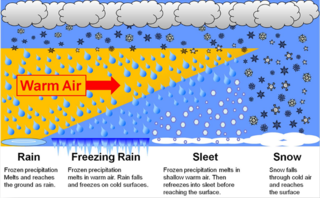
In meteorology, the different types of precipitation often include the character, formation, or phase of the precipitation which is falling to ground level. There are three distinct ways that precipitation can occur. Convective precipitation is generally more intense, and of shorter duration, than stratiform precipitation. Orographic precipitation occurs when moist air is forced upwards over rising terrain and condenses on the slope, such as a mountain.

Rain is water droplets that have condensed from atmospheric water vapor and then fall under gravity. Rain is a major component of the water cycle and is responsible for depositing most of the fresh water on the Earth. It provides water for hydroelectric power, plants, crop irrigation, and suitable conditions for many types of ecosystems.

A transient condensation cloud, also called a Wilson cloud, is observable surrounding large explosions in humid air.

A homogenitus, anthropogenic or artificial cloud is a cloud induced by human activity. Although most clouds covering the sky have a purely natural origin, since the beginning of the Industrial Revolution, the use of fossil fuels and water vapor and other gases emitted by nuclear, thermal and geothermal power plants yield significant alterations of the local weather conditions. These new atmospheric conditions can thus enhance cloud formation.

Sachchida Nand Tripathi is an Indian scientist who works in the field of Atmospheric Sciences. He is a Professor in the Department of Civil Engineering at Indian Institute of Technology, Kanpur. He currently holds the Arjun Dev Joneja Faculty Chair in the department. Council for Scientific and Industrial Research Government of India awarded him with Shanti Swarup Bhatnagar Award for Science and Technology, the highest science award in India, for his outstanding contribution in the field of Earth, Atmosphere, Ocean and Planetary sciences in 2014. Prof. Tripathi is an elected Fellow of major Sciences and Engineering academies of the country: Indian National Science Academy, National Academy of Sciences, Indian National Academy of Engineering and also holds J. C. Bose Fellowship of Department of Science and Technology (India).

The Cold Atom Laboratory (CAL) is an experimental instrument on board the ISS, which launched in 2018. It creates an extremely cold microgravity environment in order to study behaviour of atoms in these conditions.
The California drought manipulation conspiracy theory is promoted by a number of independent researchers, self-proclaimed scientists, and alternative news outlets. The theory proposes that the 2011–2017 drought was a deliberate, man-made phenomenon, created by weather modification. The theory has been dismissed by the scientific community and mainstream media as fringe science or pseudoscience.
The United Arab Emirates Research Program for Rain Enhancement Science (UAEREP) is a global research initiative offering a grant of US$5 million over a three-year period to be shared by up to five winning research projects in the field of rain enhancement.
Samy El-Shall is an Egyptian-American physical chemist and a researcher in nanoscience, heterogeneous catalysis, molecular clusters and cluster ions, nucleation and ion mobility. He is the Mary Eugenia Kapp Endowed Chair in Chemistry and Commonwealth Professor at Virginia Commonwealth University (VCU).
References
- ↑ Aditi Mathur (2011-09-02). "Laser-Assisted Technique Can Control Rainfall and Reduce Flooding: Study". International Business Times . Retrieved 2016-06-18.
- ↑ Ian Sample (2011-08-30). "Firing laser beams into the sky could make it rain, say scientists". The Guardian . Retrieved 2016-06-18.